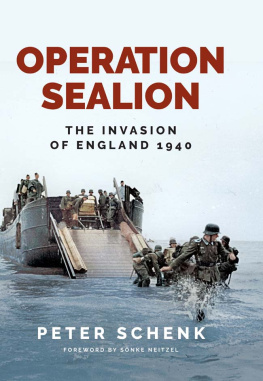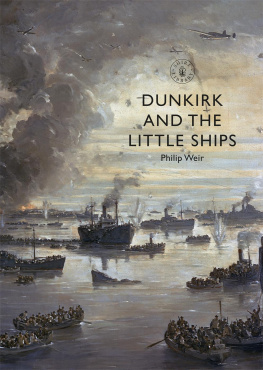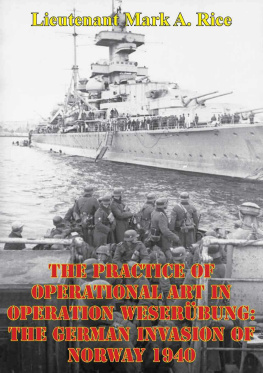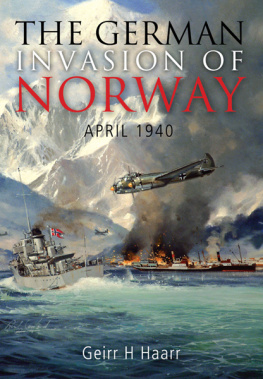Pagebreaks of the print version

OPERATION SEALION
OPERATION SEALION
The Invasion of England 1940
PETER SCHENK
Foreword
by
Snke Neitzel
Operation Sealion:
The Invasion of England 1940
This edition published in 2019 by
Greenhill Books,
c/o Pen & Sword Books Ltd,
47 Church Street, Barnsley,
S. Yorkshire, S70 2AS
www.greenhillbooks.com
ISBN: 978-1-78438-394-7
First published in Germany in 1987 as
Landung in England
by Oberbaum Verlag, Berlin
First published in English as
Invasion of England 1940: The Planning of Operation Sealion
by Conway Maritime Press, 1990
All rights reserved.
Peter Schenk, 2019
Snke Neitzel foreword Greenhill Books, 2019
The right of Peter Schenk to be identified as author of this work has been asserted in accordance with Section 77 of the Copyrights Designs and Patents Act 1988.
CIP data records for this title are available from the British Library
Designed and typeset by Donald Sommerville
Typeset in 11/14 pt Arno Pro Small Text
Preface
AFTER THE FALL OF FRANCE in June 1940 Hitler was near the height of his power. Only one enemy remained Great Britain which he did not wish to fight with but which would not give in. His real aims were in the east. If he started an eastern campaign without overwhelming Britain first he ran the risk of a two-front war, especially if Britain was supported by the USA. So an air battle was started and an invasion across the Channel prepared. When the air war did not achieve the desired result the invasion was not considered any longer. This became the turning point of the war, the abandoning of Operation Sealion, the planned invasion of Great Britain.
Though the preparations were significant for this reason, they were also important because they heralded a new aspect of modern warfare, amphibious operations. For the first time, a modern army, with its vehicles and equipment, was to be landed on a defended coast, far from any harbour. A new class of warship, landing craft, was developed, and troops with specialised equipment were brought into existence. This book concentrates on these less familiar aspects of the preparations for Operation Sealion.
May I take this opportunity to thank Dr Dieter Jung, without whose help and active support this book would not have been completed.
I would also like to express my gratitude to Lt Colonel (Retd) Randolf Kugler, who provided many of the technical details for the book. Messrs Arno Abendroth and Norbert Kelling, colleagues in the Erich Grner Study Group, were of great assistance in selecting and retouching photographs. Thanks are also due to the Director of Archives, Dr H. Maierhfer and Mr Meyer, Curator of the Military Archives of the Federal German Archives (Bundesarchiv), who were most helpful in searching out the files on which this work was based. The Historical Archives of Friedrich Krupp GmbH also provided documents which helped to complete the picture of some of the technical developments. The following also provided information for this book: R. L. Bridges; Colonel (Retd) E. Dennerlein, who played a major part in the development of Siebel ferries and gave details of Engineer Battalion 47; L. Frdrich, A. Gibbons; Lt Colonel (Retd) Haussmann; R. Kramer; W. Khling; G. Freiherr von Ledebur; C. Partridge; Lt Colonel (Retd) Rudloff; Vice-Admiral (Retd) F. Ruge (deceased); Captain (Retd) E. Rseke; Commander (Retd) G. Strempel and B. Wenzel. I would like to express my gratitude to them, as well as to Mrs M. Suykerbuyk.
Photographs were provided by the Bibliothek fr Zeitgeschichte, Stuttgart; the Bundesarchiv, Koblenz; the Historical Collection of the Naval School at Mrwik; the Imperial War Museum, London; and Messrs H. Christiansen, Colonel (Retd) E. Dennerlein, L. Frdrich, F. Hausen, H. Hildebrand, Dr D. Jung, G. Rehwald, H. Rindt, Captain (Retd) E. Rseke, F. Selinger, T. Siersdorfer and K. Tough. Mrs M. Schenk-Lovison helped in countless ways producing this book, and deserves my special thanks.
Mr E. Mahlo was kind enough to read the manuscript.
Lack of space meant a list of the ships prepared for the operation could not be included, but lists of them are to be found in Volume 6 and 7 of Grner, Die Deutschen Kriegsschiffe 18151945 , Koblenz, 1989 and 1990.
Peter Schenk
Berlin, 1990
Preface to the Second Edition
ALTHOUGH ALMOST THIRTY YEARS have passed since the first publishing of my book, it can be stated that no new sources have turned up in these years to change fundamentally the arguments of this work. Most of the later books have drawn on this work. What has changed over the years is my personal view on the German efforts and their meaning for the outcome of the war. Being more optimistic for the chances of the operation when reading all the enormous efforts made by the German side in the preserved files in the archives, I am nowadays inclined to follow the view of Admiral Karlgeorg Schuster, who in 1940 as Commanding Admiral France had been the head of the landing preparations. In his recollections, written in April 1952, he concluded that for the jump of Sealion the shield was missing, a sufficient fleet to counter the British Navy.
The photos are from the my own collection if not otherwise stated.
I would like to thank Prof Dr Snke Neitzel for the preface to this second edition.
Peter Schenk
Berlin, 2019
Foreword
ON 22 JUNE 1940, IT SEEMED that Hitler had won the war. France had surrendered and the British Expeditionary Force had been driven from the continent. No one had previously allowed that the Wehrmacht would be capable of defeating the Western military alliance within six weeks. Even the Germans had not really reckoned with such success: on the contrary, their generals had urgently warned against attacking France, their nemesis. A military campaign devised by Erich von Manstein, which completely surprised the Allies, provided the foundation for the Germans unexpected victory. There was also the additional fact that, beginning on 10 May 1940, the Belgians, French and British did pretty much everything wrong that they could.
The fact that Great Britain continued fighting after the shock of defeat in the summer of 1940, and did not seek an arrangement with the German Reich, rightly qualifies as one of the most important milestones of the Second World War. On the German side, there was no consensus about how the war should be brought to an end. The Luftwaffe believed that the UK could be bombed into a peace settlement; the Navy bet on a long-term blockade; and the Army was the only branch of the armed forces that advocated an invasion. The Luftwaffe was forced to recognise the limits of its options in August and September of 1940; the Navys capabilities were very limited in any case in 1940; and the rejection of a landing on the southern coast of England on 17 September 1940 rendered the Armys considerations obsolete.
Although Operation Sealion never too place, Peter Schenks lucid analysis shows how rewarding it is to take a more intensive look at the German preparations for a landing in England. He convincingly demonstrates how Hitler had not planned actually to implement plans for the operation. Sealion was in the final analysis never more than a means of applying pressure to force Great Britain into a settlement with Germany. Only the Army really took the planning seriously, while Hitler allowed the Luftwaffe and the Navy to maintain a half-hearted attitude. The German plans for the attacks on Norway and France could scarcely have been more different; if we look at the plans for Operation Sealion, we seek in vain for clear orders, innovation, and the dedication of branches of the armed forces. This plan would obviously never have worked. However, this should not lead historians to the premature conclusion that a German landing in England in the late summer of 1940 would have been condemned per se to failure, and Peter Schenk is right to point this out.














